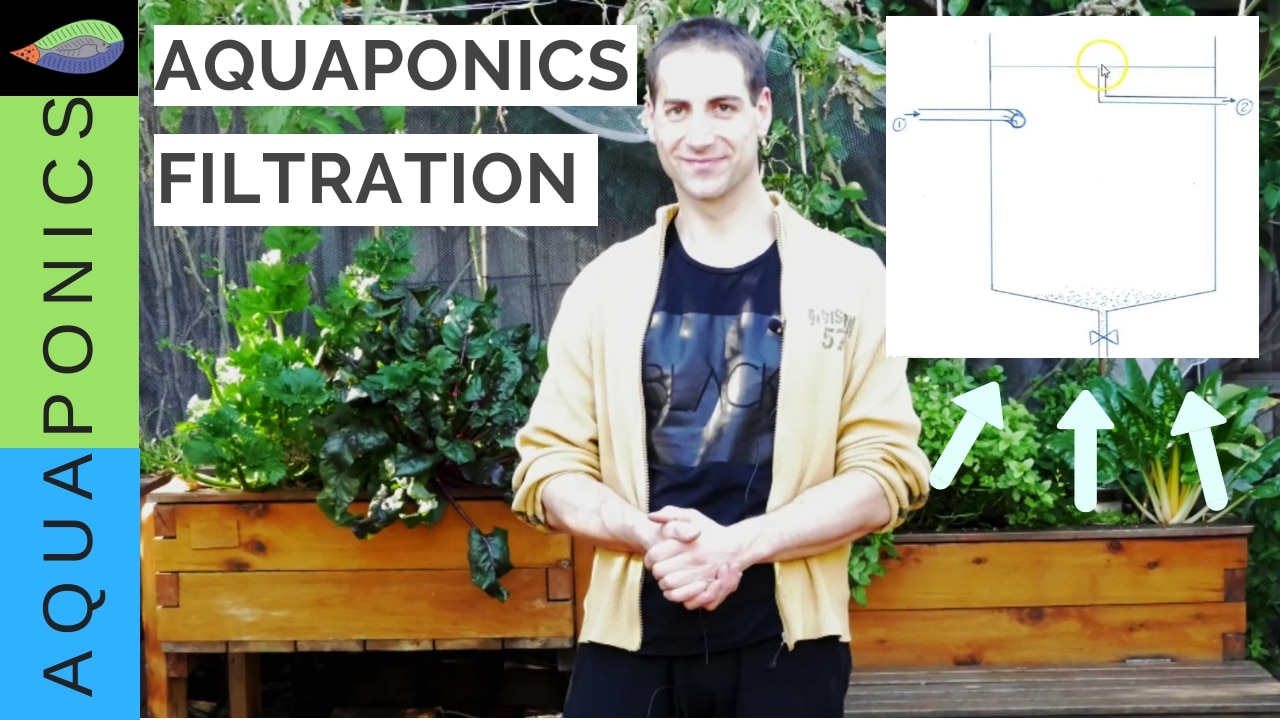Let’s talk aquaponics filtration!
In aquaponics, the bacteria are transforming the ammonia into nitrite and into nitrate. By consuming the most toxic elements, the bacteria purify the water for the fish. From this point of view, the system seems self-sufficient. No extra filtration seems needed. But, In reality, the media of a classic flood and drain system is slowly loading with organic matters. After few years, some areas of the media can clog. As a result, the system can turn anaerobic (without oxygen) which can have negative effects. Hence, a grow-bed clean up is necessary to evacuate the extra organic matters.
Adding an extra mechanical filtration to the system may help and decrease the maintenance. capturing the solids will also keep ammonia and nitrite levels lower. We can then use this captured organic matter to fertilize the classic garden. In theory it could even allow to stock more fish into the aquaponics system.
By removing part of those particles we decrease the clogging effect. Therefore we can decrease the grow-bed maintenance frequency.
Are you using another aquaponics technique than Flood and drain aquaponics? If you work with Deep Water Culture (DWC) or Nutrient Film Technique (NFT), a filtration is necessary. In those types of systems, it is very important to keep the solids away from the plant roots. Hence, we must install a filtration after the fish tank.
The impact of fish food quality
The quality of fish food used will determine the quantity and quality of the fish waste produced. The fish food produced for aquaculture is generally offering a high Digestibility. In other words, the quantity of waste rejected by the fish will be lower. Also, the fish waste is generally more solid and tend to stay together. Hence, it is easier to filter than a diluted waste. As a result, a qualitative fish food will make water filtration more efficient.
3 types of aquaponics filtration:
There are 3 main types of filtration used in aquaculture and aquaponics. The most known are the “mechanical filtration” and “biological filtration“. A third filtration rarely used in Aquaponics is the UV filtration.
So let’s go through those different filtration methods:
Mechanical filtration
Mechanical filtration consist of filtering the water from the largest physical particles. Those particles are generally organic particles.
There are different types of mechanical filters. Some are pushing the water through a screen/mesh/foam or membrane. The particles are then trapped into the mesh.
Other types of mechanical filters or clarifiers are simply working with natural forces. Those forces include gravity and centrifugal forces. Those filters are interesting since they almost don’t require maintenance. Let’s go through those different filters one by one. let’s start with the screen filters:
Rotary drum filter

This type of filter is highly used in aquaculture to filter large volumes of water.
However, it can be interesting for large scale or commercial aquaponics. This filter contains a rotating drum with a thin mesh. when the water goes through, the particles remain on the mesh. As the drum rotate, the particles are raised and a thin water spray pushes it through a gutter.
Advantage:
- It allows to filter a large water flow.
Inconvenient:
- Not well adapted to small volumes
- It consumes electricity to rotate the drum and to pump a continuous spray of water on top of the drum.
- It collects solids with a stream of water (from the water spray). Hence, another operation is necessary to dry this “waste”
- The cost is significant
Foam filter
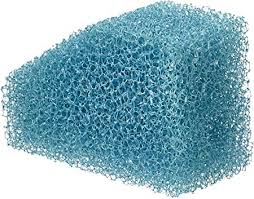
Those filters are widely used among pond lovers. They are very well adapted to backyard aquaponics. The purpose of those filters is to push the water through different layers of foam. The layers of foam are going from the largest porosity to the smallest. hence, the large particles stop at the first foam and the small particles stop at the last foam sheet. The clear water is able to go through.
Sometimes the foam filter are kept in a canister and the water pump is integrated. Hence, we call them canister filter
Advantages:
- Placed on an aquaponics water flow, this system doesn’t consume energy and simply works with gravity.
- Can be efficient and retain a large quantity of solids.
- The foam also offers a large surface area to the bacteria. Hence, this mechanical also has a biological activity.
- Low cost
Inconvenients:
- The main inconvenient of this type of filtration in my view is the need for maintenance. Indeed, the foam can rapidly clog with particles. You will need to regularly clean the foam.
There are more passive ways to filter the water. However, this system is great if the water is not too loaded.
Gravity filters, my favorite for aquaponics filtration
Swirl filter
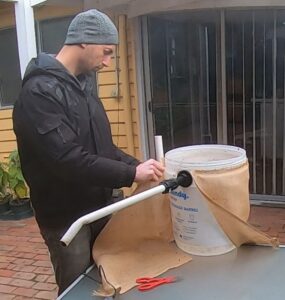
The Swirl filter works thanks to a combination of the 2 forces that are the centrifugal and gravity forces. The loaded water (from the fish tank) arrives into a large drum through a pipe with a tangential angle. It forms a kind of vortex. So the water flow is rotating following the drum wall . Thanks to the water speed, the particles are centrifugally pushed against the walls. Hence, only “Clean water” can access the center of the drum where the evacuation pipe is. The particles then slowly fall down and accumulate on the bottom of the tank. You can then collect those particles. Either with a siphon or thanks to an evacuation pipe with valve on the bottom of the tank. The larger the drum diameter is and the more efficient the swirl filter will be.
Advantages:
- This system doesn’t consume energy and simply works with gravity.
- The maintenance needed is very limited! You simply need to flush the solids towards your classic garden once in a while.
- It can be efficient and retain a large quantity of solids.
- Pretty easy to make, can be a diy project
Low cost
Inconvenient:
- I honestly don’t see any inconvenient to this system.
Radial filter
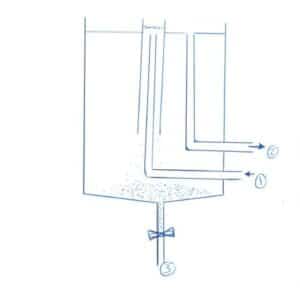
The radial filter works thanks to gravity. In this filter we will modify the water speed. The idea is to obtain a water speed lower than the speed of particles moved by gravity. To do so we must use the following formula: Water flow = Surface x Speed.
Here is the water flow principle of a radial filter:
The water is entering the drum thanks to a pipe of a limited diameter. This pipe is coming from the bottom and raising up to the top of the tank. Another pipe of a larger section is attached from the top and placed around the smaller pipe. It dives down to 4/5th of the tank depth. When the water goes from the small pipe to the larger diameter pipe, the water speed decrease.
This is due to the fact that the surface (or pipe section) of the pipe increase. Then the water falls down slowly and is finally released into the large drum where the section is huge. At this point, the gravity force on the large particles is stronger than the water speed. Hence, the particles fall down on the bottom of the tank where they can be collected as in a swirl filter.
Advantages:
- This system doesn’t consume energy and simply works with gravity.
- The maintenance needed is very limited! You simply need to flush the solids towards your classic garden once in a while.
- It can be efficient and retain a large quantity of solids.
- Low cost and easy to make, can be a diy project
Inconvenient:
- I don’t see any inconvenient to this system for aquaponics filtration.
Surface filters
The elements we want to filter in aquaponics are often solids. Some of them are floating and it can be interesting to have a special system to collect them. Sometimes we want to filter the floating lipids. Let’s go through those 2 systems:
Sieve filter
 A classic sieve filter is positioned under the overflow and collect the large floating particles such as tree leaves
A classic sieve filter is positioned under the overflow and collect the large floating particles such as tree leavesAdvantages:
- Very basic and efficient to filter leaves and keep the water surface clean
- Requires a low maintenance
- Low cost
Inconvenient:
- Is sometimes made of metal which is not recommended for aquaponics
- Doesn’t filter small particles
Skimmer
There are different types of skimmers. Most of them are designed for saltwater. They create an emulsion between the air and the particles. it forms a foam that floats and is evacuated. However, in aquaponics those types of skimmers are rarely used.
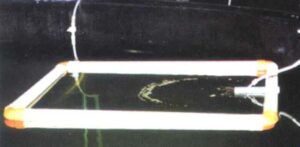 Another type of skimmers more interesting for us are systems used in fish hatcheries. When fish are born, they go through different stages. At one stage, the fish must blow his bladder. The bladder is like a balloon inside the fish, allowing it to balance his body in the water. In order to blow his bladder, the fish swims towards the surface and absorb some air.
Another type of skimmers more interesting for us are systems used in fish hatcheries. When fish are born, they go through different stages. At one stage, the fish must blow his bladder. The bladder is like a balloon inside the fish, allowing it to balance his body in the water. In order to blow his bladder, the fish swims towards the surface and absorb some air. Unfortunately, in aquaculture, the fish food used is often loaded with lipids. Those lipids sometimes form a thin layer on the surface of the water. This layer can prevent the young fish from accessing the air. In this instance, the fish will simply die. Hence, the fish farmers invented some floating skimmers. They blow air flow on the surface of the water to push the water towards a “Cage” where the lipids are trapped. This type of skimmer can filter lipids but also any particle or object floating on the surface of the water. This is interesting if your system is close to trees as it can filter leaves before they sink.
Advantages:
- Efficient to filter leaves and keep the water surface clean
- Easy to build
Inconvenient:
- Requires an air pump
- Requires a maintenance to regularly empty the “cage”
Pressure filters
We will now go through a series of filters working under pressure. They are often interesting for aquaculture, large scale aquaponics or water treatment. However, I wouldn’t recommend it for backyard aquaponics. Indeed, high pressure induce a higher energy consumption. If you don’t plan to work on a large scale system, you can skeep this chapter and go to the biological filtration.
Sand filter
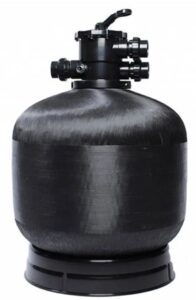 With the sand filter, the water goes through a sand bed contained in a pressurized container. The water can only flow in the space between the sand grains, hence, it blocks the solids. Those filters require pressure to push the water through the sand at an acceptable speed.
With the sand filter, the water goes through a sand bed contained in a pressurized container. The water can only flow in the space between the sand grains, hence, it blocks the solids. Those filters require pressure to push the water through the sand at an acceptable speed.Advantages:
- Very effective, it allows to filter thin particles.
- The pressure allows to filter a high water flow
Inconvenient:
- The system works in pressure which means a higher electricity consumption
- Those filters require regular backwash. With solenoid valves, it can be automatized, however, each backwash consumes water
- Costly equipment
Cartridge filter
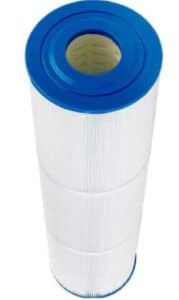
Cartridge filters consist of pushing the water through a thin membrane. Several membrane thickness exist and can filter up to very low size under 1 micron.
Advantages:
- It allows to filter very thin particles.
Inconvenient:
- The system works in pressure which means a higher electricity consumption
- The cartridge must be replaced regularly
- They are not adapted to high water flow.
- running several cartridge filters can represent a budget
Reverse osmosis

Those filters are the thinnest ones, we talk about nano-filtration. They push the water through a ceramic (or polymeric) membrane. Only the water particles are thin enough to go through. All other substances and ions are filtered away.
Advantages:
- It allows to obtain an almost pure water.
Inconvenient:
- The system works in significant pressure which means a higher electricity consumption
- They produce a quantity of wasted water.
- They are not adapted to high water flow.
- The pure water must then be ionized to be used.
- Pricy
Let’s be clear, this system is almost never used in classic aquaponics filtration.
Biological filtration
The purpose of a biological filter (also called bio-filters or bio-reactors) is to transform the fish waste into nitrate.
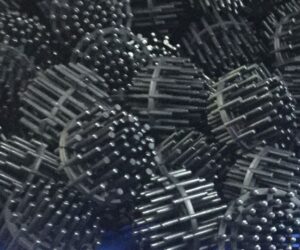
Bio-filters are generally composed of a media (plastic pearls / plastic balls / ceramic balls…) placed in an aerated tank. Bacteria colonize the media. As a result, it contributes to the mineralization of the nitrogen released by the fish.
Most of the current bio-filters are auto cleaned. They require a significant concentration of aeration to keep the media in movement. First, the aeration provides an aerobic environment for the bacteria. But also allows the pearls to move and chock to each other so organic matters can’t build up.
UV filtration
The UV filter kills part of the bacteria, virus and algae in suspension into the water. The running water runs around a UV light (in transparent pipes). The UV can only be efficient on “clear water”. If the water contains particles, the efficiency decrease.
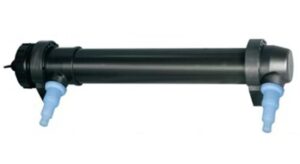
UV filters are generally used in recirculated systems. We position them after the mechanical filtration, just before the biological filter. Hence, it avoids contamination of the bio-filter by unwanted bacteria. It is also sometimes used after the biological filter to avoid some bacteria/virus to go into the fish tank. In backyard aquaponics, the systems are completely open. A multitude of bacteria are constantly entering the system. The need of such filtration is therefore reduced. UV filters are also used in ornamental ponds to kill the algae and keep the water clear.
The best flood and drain aquaponics filter
We went through a fair bit of information and you may wonder “what is the best type of filter for aquaponics?“. in my opinion Swirl filter and Radial filter are the best for aquaponics. They can filter a huge quantity of solids and require a minimum quantity of maintenance. Furthermore, you can build them by yourself. If you wonder “How do you make an aquaponics filter?” Here is a free step by step training to build your own Swirl filter.
If you run a flood and drain aquaponics system and respect the fish density recommended in my free training. That is to day less than 1kg of fish per 50 litres of efficient grow-bed media. Then, you don’t need extra biological filtration. If you are using another aquaponics technique (DWC or NFT), I recommend to use a bio-filter.
What should you do with the filtered solids?
Most of the substances trapped by the filters are fish waste. With aquaponics, we prove that fish waste can become precious nutrient for plants. Hence, my best advise is to use those solids as a natural plant fertilizer for your classic garden.
You will probably be interested to discover my six steps to build and manage an Aquaponics system. Click here to access for free! Thanks and good reading 🙂


